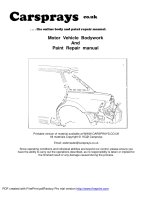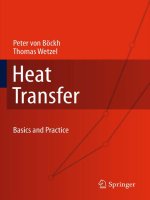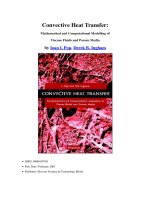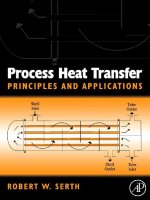36S08T0 transfer case and 4x4 repair 2006
Bạn đang xem bản rút gọn của tài liệu. Xem và tải ngay bản đầy đủ của tài liệu tại đây (2.65 MB, 130 trang )
manual
transmission
and driveline
transfer case
and 4x4
system repair
FCS-14358-REFi gk ig
student guide
COURSE CODE: 36S08T0
ORDER NUMBER: FCS-14358-REF
Updated January, 2006
Ford Customer Service Division
Technical Training
IMPORTANT SAFETY NOTICE
Appropriate service methods and proper repair procedures are essential for the safe, reliable operation of all motor vehicles,
as well as the personal safety of the individual doing the work. This manual provides general directions for accomplishing
service and repair work with tested, effective techniques. Following them will help assure reliability.
There are numerous variations in procedures, techniques, tools and parts for servicing vehicles, as well as in the skill of the
individual doing the work. This manual cannot possibly anticipate all such variations and provide advice or cautions as to
each. Accordingly, anyone who departs from instructions provided in this manual must first establish that he compromises
neither his personal safety nor the vehicle integrity by his choice of methods, tools or parts.
As you read through the procedures, you will come across NOTES, CAUTIONS, and WARNINGS. Each one is there for a
specific purpose. NOTES give you added information that will help you to complete a particular procedure. CAUTIONS are
given to prevent you from making an error that could damage the vehicle. WARNINGS remind you to be especially careful
in those areas where carelessness can cause personal injury. The following list contains some general WARNINGS that
you should follow when you work on a vehicle.
•
•
Always wear safety glasses for eye protection.
•
•
•
To prevent serious burns, avoid contact with hot metal
parts such as the radiator, exhaust manifold, tail pipe,
catalytic converter and muffler.
Be sure that the ignition switch is always in the OFF
position, unless otherwise required by the procedure.
•
•
Do not smoke while working on the vehicle.
Set the parking brake when working on the vehicle. If you
have an automatic transmission, set it in PARK unless
instructed otherwise for a specific service operation. If
you have a manual transmission it should be in REVERSE (engine OFF) or NEUTRAL (engine ON) unless
instructed otherwise for a specific service operation.
•
Keep hands and other objects clear of the radiator fan
blades. Electric cooling fans can start to operate at any
time by an increase in underhood temperatures, even
though the ignition is in the OFF position. Therefore, care
should be taken to ensure that the electric cooling fan is
completely disconnected when working under the hood.
Use safety stands whenever a procedure requires you to
be under the vehicle.
•
Operate the engine only in a well-ventilated area to avoid
the danger of carbon monoxide.
•
Keep yourself and your clothing away from moving parts
when the engine is running, especially the fan and belts.
To avoid injury, always remove rings, watches, loose
hanging jewelry, and loose clothing before beginning to
work on a vehicle. Tie long hair securely behind your
head.
The recommendations and suggestions contained in this manual are made to assist the dealer in improving his dealership parts
and/or service department operations. These recommendations and suggestions do not supersede or override the provisions of
the Warranty and Policy Manual, and in any cases where there may be a conflict, the provisions of the Warranty and Policy Manual
shall govern.
The descriptions, testing procedures, and specifications in this handbook were in effect at the time the handbook was
approved for printing. Ford Motor Company reserves the right to discontinue models at any time, or change specifications,
design, or testing procedures without notice and without incurring obligation. Any reference to brand names in this manual
is intended merely as an example of the types of tools, lubricants, materials, etc. recommended for use. Equivalents, if
available, may be used. The right is reserved to make changes at any time without notice.
WARNING: MANY BRAKE LININGS CONTAIN ASBESTOS FIBERS. WHEN WORKING ON BRAKE COMPONENTS, AVOID
BREATHING THE DUST. BREATHING THE ASBESTOS DUST CAN CAUSE ASBESTOSIS AND CANCER.
Breathing asbestos dust is harmful to your health.
Dust and dirt present on car wheel brake and clutch assemblies may contain asbestos fibers that are hazardous to your health
when made airborne by cleaning with compressed air or by dry brushing.
Wheel brake assemblies and clutch facings should be cleaned using a vacuum cleaner recommended for use with asbestos fibers.
Dust and dirt should be disposed of in a manner that prevents dust exposure, such as sealed bags. The bag must be labeled per
OSHA instructions and the trash hauler notified as to the contents of the bag.
If a vacuum bag suitable for asbestos is not available, cleaning should be done wet. If dust generation is still possible, technicians
should wear government approved toxic dust purifying respirators.
OSHA requires areas where asbestos dust generation is possible to be isolated and posted with warning signs. Only technicians
concerned with performing brake or clutch service should be present in the area.
Copyright © 2002 Ford Motor Company
Produced and Coordinated by
Technical Support Operations
Ford Customer Service Division
February, 2002
CUSTOMER EXPECTATIONS
Customer Expectations: Service
1. Make it convenient to have my
vehicle serviced at your dealership.
2. The Service Advisor should
5. Provide me with a clear and thorough
explanation of the service performed.
6. Call me within a reasonable amount of
demonstrate a genuine concern for
my service needs.
time after my service visit to ensure that
I'm completely satisfied.
3. Fix it right the first time.
4. Complete servicing my vehicle in a
7. Be responsive to questions or concerns
I bring to your attention.
timely and professional manner.
Expectation 3
“Fix It Right The First Time, on Time.”
Both service advisors and technicians are important players when it comes to Expectation
#3.
Why
Customers tell us “Fixing It Right The First Time, on Time” is one of the reasons they
would decide to return to a dealer to buy a vehicle and get their vehicles serviced.
Technician Training
It is our goal to help the technician acquire all of the skills and knowledge necessary to
“Fix It Right The First Time, on Time.” We refer to this as “competency.”
Technician’s Role
Acquire the skills and knowledge for competency in your specialty via:
STST
New Model
– Self Study
– Self Study
– FordStar Broadcasts
– FordStar Broadcasts
– Ford Multimedia Training (FMT)
– Instructor Led
– Instructor Led
The Benefits
The successful implementation of expectations means:
– Satisfied customers
– Repeat vehicle sales
– Repeat service sales
– Recognition that Ford and Lincoln/Mercury technicians are “the Best in the
Business”
TABLE OF CONTENTS
DAY ONE
INTRODUCTION .......................................................................................................... INTRO-1
Day One Flowchart .................................................................................................................... Intro-4
Day One Agenda ....................................................................................................................... Intro-5
Prerequisite Review Questions ................................................................................................... Intro-7
LESSON 1 ..............................................................................................................................1-1
Worksheet A (Video) 4x4 Vehicle Features (Desk) .......................................................................... 1-2
Student’s Answer Sheet ........................................................................................................... 1-2
4x4 Driveline ................................................................................................................................... 1-4
Transfer Case ................................................................................................................................... 1-5
Front Axle ........................................................................................................................................ 1-6
Front Driveshaft ............................................................................................................................... 1-7
Locking Wheel Hubs ....................................................................................................................... 1-8
Proper Gear Selections for Driving Conditions .............................................................................. 1-10
Mechanical Components ................................................................................................................ 1-11
LESSON 2 ..............................................................................................................................2-1
Powerflow 13-54 Electronic Shift On The Fly (ESOF) Transfer Case ............................................ 2-2
Powerflow 44-05 Transfer Case ....................................................................................................... 2-4
Powerflow 44-06 Transfer Case ....................................................................................................... 2-6
Powerflow NV273 Transfer Case .................................................................................................... 2-8
Viscous Coupling ........................................................................................................................... 2-10
Worksheet B Viscous Coupling (Desk) .......................................................................................... 2-12
Student’s Answer Sheet ......................................................................................................... 2-12
Electronic Clutch Assembly ........................................................................................................... 2-14
Worksheet C (Video) A4WD Electronic Clutch (At Desk) ............................................................ 2-16
Student’s Answer Sheet ......................................................................................................... 2-16
2001 Escape Four Wheel Drive (4WD) System ............................................................................ 2-17
Operating Modes of the 2001 Escape 4WD System ...................................................................... 2-18
2001 Escape Rotary Blade Coupling (RBC) ................................................................................. 2-19
2001 Escape Rotary Blade Coupling (RBC) Operation ................................................................. 2-20
2001 Escape Electromagnetic Clutch Operation ............................................................................ 2-21
Worksheet D (At Workstation # 1) 13-54 Disassembly & Assembly (Bench) ............................... 2-23
Student’s Answer Sheet ......................................................................................................... 2-23
Worksheet E (At Workstation # 2) 44-05 Disassembly & Assembly (Bench) ................................ 2-24
Student’s Answer Sheet ......................................................................................................... 2-24
Worksheet F (At Workstation # 3) 44-06 Disassembly & Assembly (Bench) ................................ 2-26
Student’s Answer Sheet ......................................................................................................... 2-26
Worksheet G (At Workstation # 4) NV 273 Disassembly & Assembly (Bench) ............................ 2-28
Student’s Answer Sheet ......................................................................................................... 2-28
Transfer Case and 4x4 System Repair
February, 2002
i
TABLE OF CONTENTS
DAY TWO
INTRODUCTION DAY TWO ......................................................................................... INTRO-1
Day Two Flowchart ................................................................................................................... Intro-1
Day Two Agenda ....................................................................................................................... Intro-2
LESSON 3 ..............................................................................................................................3-1
Front Axles ....................................................................................................................................... 3-2
Locking Wheel Hub Components .................................................................................................... 3-4
LESSON 4 ..............................................................................................................................4-1
Diagnostic Process ........................................................................................................................... 4-2
Front driveline concerns ................................................................................................................... 4-4
Diagnosing Sub-systems .................................................................................................................. 4-6
Diagnostic Process ........................................................................................................................... 4-8
Scan tools ....................................................................................................................................... 4-10
Normal Operating Characteristics/Customer Concerns .................................................................. 4-10
4WD Concerns .............................................................................................................................. 4-11
Hub Diagnosis ............................................................................................................................... 4-12
NVH Concerns .............................................................................................................................. 4-14
Worksheet H Scan Tool Usage (on Vehicle) .................................................................................. 4-17
Student’s Answer Sheet ......................................................................................................... 4-17
Worksheet I Scan Tool Diagnosis (On Vehicle) ............................................................................. 4-19
Student’s Answer Sheet ......................................................................................................... 4-19
Worksheet IA Service Publication Navigation (Paper Exercise) .................................................... 4-21
Student’s Answer Sheet ......................................................................................................... 4-21
Worksheet J 13-54 ESOF (Ranger 4.0L) ....................................................................................... 4-22
Student’s Answer Sheet ......................................................................................................... 4-22
Worksheet K 44-06 A4WD Expedition ......................................................................................... 4-23
Student’s Answer Sheet ......................................................................................................... 4-23
Worksheet L (At Bench) Shift Motor Sense Plate Exercise ........................................................... 4-24
Student’s Answer Sheet ......................................................................................................... 4-24
Worksheet M (Desk) Diagnostic Procedure (Paper Exercise) ........................................................ 4-25
Student’s Answer Sheet ......................................................................................................... 4-25
DAY THREE
INTRODUCTION .......................................................................................................... INTRO-1
Day Three Flowchart ................................................................................................................. Intro-1
Day Three Agenda ..................................................................................................................... Intro-2
ii
February, 2002
Transfer Case and 4x4 System Repair
DAY ONE
INTRODUCTION
Manual Transmission and Drivetrain Curriculum
The Manual Transmission and Drivetrain Curriculum Path consists of eight courses. Each course is one of the
following types:
Self-Study – This type of course is a self-paced program. The technician is responsible for learning the
material on his or her own. The training material consists of a reference book and accompanying videotape.
The videotape is designed to support the material in the reference book and should not be used on its own.
Ford Multimedia Training (FMT) – This type of course is also self-paced. The multimedia course allows the
technician to interact with the training materials. The multimedia course allows the technician to utilize the
knowledge attained in the self-study course. The FMT concentrates on relationships, such as the cause- andeffect relationships between symptoms and components.
Distance Learning (FORDSTAR) – This type of course is an instructor-led, interactive type. It is presented
over the FORDSTAR Distance Learning Network. The instructor can present information to, relate questions
to, and interact with the technicians. Demonstrations and video presentations are used to introduce material.
Classroom – The classroom course allows for practical, real-world application of skills and knowledge learned
in the other courses.
The eight courses included in the Manual Transmission and Drivetrain Curriculum are as follows:
Differential and Driveline Operation – Self-Study ........................................................ Course code: 36S01S0
Differential and Driveline Repair – Classroom ............................................................. Course code: 36S02T0
Manual Transmission/Transaxle Operation – Self-Study .............................................. Course code: 36S03S0
Manual Transmission/Transaxle Diagnosis – FMT ....................................................... Course code: 36S04M0
Manual Transmission/Transaxle Repair – Classroom ................................................... Course code: 36S05T0
Transfer Case and 4x4 System Operation – Self-Study ................................................. Course code: 36S06S0
Transfer Case and 4x4 System Diagnosis – FORDSTAR ........................................ Course code: 36S07F0
*
Transfer Case and 4x4 System Repair – Classroom ............................................. Course code: 36S08T0
* All students must have completed the Transfer Case and 4x4 System Operation Self-Study Course as well
as the Transfer Case and 4x4 System Diagnosis – FORDSTAR prior to enrolling in this course. Students
who have not completed the previous course should not be admitted to this class. Their presence will slow
down the course flow, as well as monopolize valuable instructor time.
Transfer Case and 4x4 System Repair
February, 2002
Intro-1
INTRODUCTION
DAY ONE
Curriculum Goals
The goals of this curriculum are:
To provide the necessary training to enable the technician to identify, diagnose, and perform timely “Fix It
Right The First Time – On Time” repairs
Increased customer satisfaction
Increased technician productivity
Fewer repeat repairs
Course Objectives
Upon completion of the Transfer Case and 4x4 System Repair Classroom Course, the technician will be able to:
Explain the components of a 4x4 system.
Explain the mechanical components of a transfer case.
Explain the powerflow of each transfer case used in this course.
Explain the operation of the viscous coupling.
Explain the operation of the A4WD electronic clutch assembly.
Perform transfer case disassembly procedures.
Perform transfer case inspection procedures.
Perform transfer case assembly procedures.
Explain the 4x4 front axles.
Explain locking wheel hubs.
Describe the Symptom-to-System-to-Component-to-Cause diagnosis process.
Perform diagnostic procedures on an electronic transfer case.
Perform locking hub inspection.
Intro-2
February, 2002
Transfer Case and 4x4 System Repair
DAY ONE
INTRODUCTION
Audience
This course is designed for Ford Motor Company dealer technicians.
Course Prerequisites
Each technician enrolled in this course must meet the following prerequisites:
Basic Electrical Part 1 – (self-study)
Basic Electrical Part 2 – (FMT)
Basic Electrical Part 3 – (classroom)
Electronics Part 1 – (self-study)
Electronics Part 2 – (FMT)
Electronics Part 3 – (classroom)
Measuring Devices – (FMT)
Noise Vibration & Harshness – (classroom)
Transfer Case and 4x4 System Operation – (self-study)
Transfer Case and 4x4 System Diagnosis – (Fordstar)
Transfer Case and 4x4 System Repair
February, 2002
Intro-3
INTRODUCTION
DAY ONE
DAY ONE
FLOWCHART
Prerequisite Review:
Self-Study and
FORDSTAR
Start of
Class
Lecture:
4x4 Components
Break
Video:
4x4 Basics
Worksheet A
Lecture:
4x4 Powerflow
Video:
Viscous Coupling
Worksheet B
Video:
A4WD
Worksheet C
Rotation #2
Worksheet E
Rotation #1
Worksheet D
Lunch
Break
Rotation #3
Worksheet F
Rotation #4
Worksheet G
End of
Day One
Intro-4
February, 2002
Transfer Case and 4x4 System Repair
DAY ONE
INTRODUCTION
DAY ONE AGENDA
The agenda for the day is as follows:
START
TASK
TASK
Start of Class
FINISH
TASK
8:30 AM
REVIEW: Prerequisite Review (Self-Study/FORDSTAR)
8:30 AM
9:30 AM
VIDEO: 4x4 Basics Video (Worksheet A)
9:30 AM
10:00 AM
BREAK
10:05 AM
10:15 AM
LECTURE: Four-Wheel Drive Components
10:25 AM
10:30 AM
LECTURE: Powerflow
10:45 AM
11:00 AM
VIDEO: “Viscous Drive” (Worksheet B)
11:05 AM
11:30 AM
VIDEO: “A4WD Electronic Clutch Video” (From SS or FORDSTAR)
(Worksheet C)
11:30 AM
12:00 AM
LUNCH
12:00 AM
1:00 PM
Divide into four Groups and Explain Workstations
1:00 PM
1:15 PM
ROTATION #1: Worksheet D
1:15 PM
2:00 PM
ROTATION #2: Worksheet E
2:00 PM
2:45 PM
BREAK
2:45 PM
3:00 PM
ROTATION #3: Worksheet F
3:00 PM
3:45 PM
ROTATION #4: Worksheet G
3:45 PM
4:30 PM
END OF DAY ONE
Transfer Case and 4x4 System Repair
4:30 PM
February, 2002
Intro-5
INTRODUCTION
DAY ONE
NOTES
Intro-6
February, 2002
Transfer Case and 4x4 System Repair
DAY ONE
INTRODUCTION
PREREQUISITE REVIEW QUESTIONS
Directions:
The prerequisite review includes fill in the blank, matching, labeling, and diagnosing.
1. The purpose of the transfer case is to ________________________________________________________
2. Locking wheel hubs are used to_____________________________________________________________
3. Match the component to the function.
Component
Function
_______
Front driveshafts
A.
use halfshafts with CV joints to allow the axles to
flex.
_______
Monobeam axles
B.
typically have U-joints, rear slip yokes, and boots
(to cover the slip yoke splines).
_______
IFS axles
C.
are used in applications where substantial amounts
of weight are expected to be added to the front of the
vehicle.
Transfer Case and 4x4 System Repair
February, 2002
Intro-7
INTRODUCTION
DAY ONE
PREREQUISITE REVIEW QUESTIONS (Continued)
4. Label the following Transfer Case Powerflows.
A
B
C
Identify Powerflows
A.
B.
C.
Intro-8
February, 2002
Transfer Case and 4x4 System Repair
DAY ONE
INTRODUCTION
PREREQUISITE REVIEW QUESTIONS (Continued)
5. The main purpose of the GEM in an A4WD system is ___________________________________________
6. Match the following by writing the correct letter in the space provided.
Transfer Case Chains
and Sprockets
Function
_______
Chain
A.
Transmits power to drive chain
_______
Driven Sprocket
B.
Transfers power to driven sprocket
_______
Drive Sprocket
C.
Receives power through chain and transfers
power to the front output shaft
7. Match the following by writing the correct letter in the space provided.
Transfer Case Clutches
and Actuation Devices
Function
_______
The viscous coupling
A.
in A4WD systems, provides torque to the
wheels to improve traction when front and
rear wheel speeds vary.
_______
The magnetic clutch assembly
B.
allows the transfer case to be shifted into
4WD at any safe speed.
_______
The clutch pack and cam/coil housing
C.
in AWD systems, provides torque to the
wheels to improve traction when front and
rear wheel speeds vary.
8. The viscous coupling is a ______________________________________________________ filled with
________________________________________________ and _____________ .
Transfer Case and 4x4 System Repair
February, 2002
Intro-9
INTRODUCTION
DAY ONE
PREREQUISITE REVIEW QUESTIONS (Continued)
9. Label each of the transfer case components. Also, indicate if the component is an input or an output.
A
B
C
4WD
HIGH
D
E
F
G
H
CRTC002-A
Identify Inputs and Outputs
A.
E.
B.
F.
C.
G.
D.
H.
Intro-10
February, 2002
Transfer Case and 4x4 System Repair
DAY ONE
INTRODUCTION
PREREQUISITE REVIEW QUESTIONS (Continued)
10. Label the transfer case planetary gearset.
A
B
C
D
Identify Planetary Gearset
A.
B.
C.
D.
Transfer Case and 4x4 System Repair
February, 2002
Intro-11
INTRODUCTION
DAY ONE
PREREQUISITE REVIEW QUESTIONS (Continued)
11. Label the driver controls.
Identify Driver Controls
A.
B.
C.
Intro-12
February, 2002
Transfer Case and 4x4 System Repair
DAY ONE
INTRODUCTION
PREREQUISITE REVIEW QUESTIONS (Continued)
Directions: Respond to questions 12 through 15 for the following diagnostic scenario.
A vehicle becomes stuck in the snow because it will not go into 4-wheel drive when commanded to do so. The
technician verifies the concern and finds the left front locking hub does not engage. He replaces the defective unit
and verifies the repair before returning the car to the customer. Use the symptom-to-system-to-component-tocause diagnosis and determine the following:
12. What is the symptom? ____________________________________________________________________
13. What is the system? ______________________________________________________________________
14. What is the component? __________________________________________________________________
15. What are some probable causes? ____________________________________________________________
16. The resources technicians should always use during A4WD diagnosis are ___________________________
17. Noise has a ________________ , _____________________ and __________________ .
18. What tool is best suited to isolate a noise concern? _____________________________________________
19. What tool do you use to isolate vibration concerns? _____________________________________________
Determine if the following characteristics are NORMAL or ABNORMAL 4x4 system characteristics.
20. Wind up on hard surface with 4WDH engaged. ________________________________________________
21. Hub/transfer case engagement clunk. ________________________________________________________
22. Locking hubs disengaging during sharp turns. _________________________________________________
23. Handling characteristics are different between 2WD and 4WDL. __________________________________
Transfer Case and 4x4 System Repair
February, 2002
Intro-13
INTRODUCTION
DAY ONE
NOTES
Intro-14
February, 2002
Transfer Case and 4x4 System Repair
DAY ONE
LESSON 1
OBJECTIVES
CONTENT
Explain the components of a 4x4 system.
4x4 Driveline
Explain the mechanical components of a transfer
case.
Transfer Case
Front Axle
Front Driveshaft
Locking Wheel Hubs
Proper Gear Selections for Driving Conditions
Mechanical Components
Transfer Case and 4x4 System Repair
February, 2001
1-1
LESSON 1
DAY ONE
WORKSHEET A (VIDEO)
4x4 VEHICLE FEATURES (DESK)
STUDENT’S ANSWER SHEET
DIRECTIONS
Answer the following questions after watching the video on 4x4 Vehicle Features:
1.
T
F
Clicking or ratcheting on 4WD engagement usually indicates driveline concerns.
2.
T
F
Aggressive tire tread patterns may produce tire noise concerns.
3.
T
F
Different steering “feel” is normal during 4x4 operation.
4.
T
F
Gear noise is a normal operating characteristic when shifting the lever operated transfer
case into 4WD LOW.
5.
T
F
Locking hubs should be serviced after being submerged in water.
6.
T
F
Automatic locking hubs are designed to automatically unlock under heavy load.
7. The procedure for engaging 4WD LOW in a vehicle with a manual transmission is as follows:
A. ___________________________________________________________________________________
B. ___________________________________________________________________________________
C. ___________________________________________________________________________________
D. ___________________________________________________________________________________
8. The procedure for disengaging 4WD LOW in a vehicle with an automatic transmission is as follows:
A. ___________________________________________________________________________________
B. ___________________________________________________________________________________
C. ___________________________________________________________________________________
D. ___________________________________________________________________________________
9. If the lever operated transfer case sticks in Neutral, which of the following methods will allow you to
complete the shift?
A. Shift to another gear
B. Locking the manual hubs
C. Letting the vehicle roll slightly
D. Shutting off engine and restarting
1-2
February, 2001
Transfer Case and 4x4 System Repair
DAY ONE
LESSON 1
WORKSHEET A (VIDEO)
4x4 VEHICLE FEATURES (DESK)
STUDENT’S ANSWER SHEET (Continued)
10. The proper way to unlock automatic locking hubs with the transfer case disengaged is to:
A. shift to 2WD.
B. turn the hub knob to the unlock position.
C. change vehicle direction for a few feet.
D. shut off the engine and restart.
11. ___________________________________ locking hubs are recommended for more severe operations.
12. For systems using part-time transfer cases, driving on high traction surfaces in 4x4 mode causes
_____________________________________________________________________________________ .
Transfer Case and 4x4 System Repair
February, 2001
1-3
LESSON 1
DAY ONE
4x4 DRIVELINE
2
1
3
4
5
6
8
7
CRTC005-A
4x4 Driveline Components
Item
Description
Item
Description
1
Rear Axle
5
Locking Hub
2
Rear Driveshaft
6
Front Differential
3
Transfer Case
7
Front Axle
4
Front Driveshaft
8
Rear Differential
The 4x4 driveline includes all the same components as a rear wheel drive driveline as well as a transfer
case, a front driveshaft, and a front drive axle (with or without locking hubs).
1-4
February, 2001
Transfer Case and 4x4 System Repair
DAY ONE
LESSON 1
TRANSFER CASE
CRTC006-A
Transfer Case
Just as in a rear wheel drive system, the engine supplies power to the transmission through the driveshaft
and rear axle to the wheels. The transfer case is the gear assembly used to control power flow to the front
axle and the rear axle. It transfers the power through one input shaft and two output shafts, one to each
drive axle. The input shaft of the transfer case is connected to the transmission output shaft.
The purpose of the transfer case is to transmit power to the rear axle (through the rear output shaft and rear
driveshaft) and to the front axle (through the front output shaft and front driveshaft). Many transfer cases include
a gear reduction mechanism to provide a lower range, usually at a 2:1 ratio. Low range is limited to 4-wheel drive
(4WD) operation because it doubles the torque to the drive axles, and this is often more than one axle is designed
to handle.
Types of Transfer Cases
The two types of transfer cases are part-time 4-wheel drive and all-wheel drive. Part-time transfer case systems
may be manually shifted, electronically shifted, or automatically shifted into 4WD. Vehicles with part-time
transfer cases operate the same as 2-wheel drive (2WD) vehicles when 4WD is not engaged. The system is only
operated in 4WD mode when commanded by the driver, or in the case of the Automatic 4-Wheel Drive (A4WD)
system, commanded by the Generic Electronic Module (GEM) or by a stand-alone four wheel drive
control module.
All-wheel drive transfer case systems are always in the 4WD mode and cannot be controlled by the driver.
The front driveline is always engaged and maintains constant power to both the front and rear axles. The
all-wheel drive transfer case has a center differential, or interaxle differential, between the front and rear
output shafts.
Transfer Case and 4x4 System Repair
February, 2001
1-5









